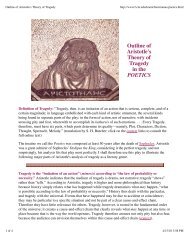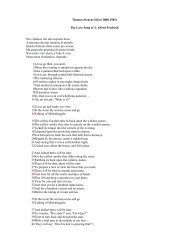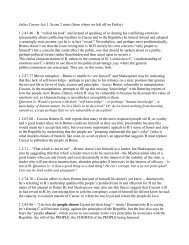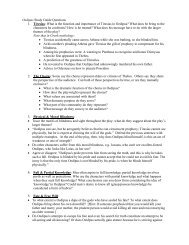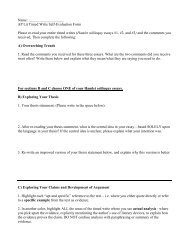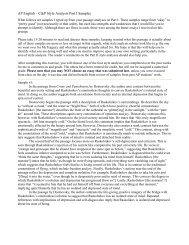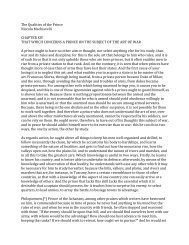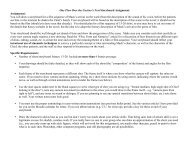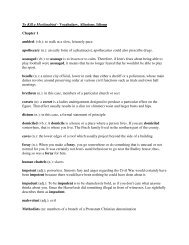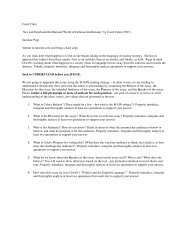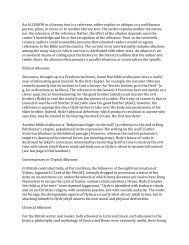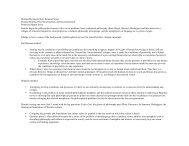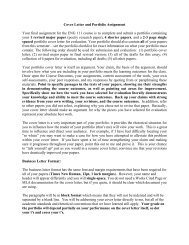50 Key Terms for AP - Adapted from: Dr. Wheeler's page of literary ...
50 Key Terms for AP - Adapted from: Dr. Wheeler's page of literary ...
50 Key Terms for AP - Adapted from: Dr. Wheeler's page of literary ...
Create successful ePaper yourself
Turn your PDF publications into a flip-book with our unique Google optimized e-Paper software.
<strong>50</strong> <strong>Key</strong> <strong>Terms</strong> <strong>for</strong> <strong>AP</strong> - <strong>Adapted</strong> <strong>from</strong>: <strong>Dr</strong>. Wheeler’s <strong>page</strong> <strong>of</strong> <strong>literary</strong> terms - http://web.cn.edu/kwheeler/index.html<br />
Underlined words indicate terms <strong>for</strong> <strong>AP</strong> English Language Exam<br />
IMAGERY: A common term <strong>of</strong> variable meaning, imagery includes the "mental pictures" that readers experience with a<br />
passage <strong>of</strong> literature. It signifies all the sensory perceptions referred to in a poem, whether by literal description, allusion, simile,<br />
or metaphor. Imagery is not limited to visual imagery; it also includes auditory (sound), tactile (touch), thermal (heat and cold),<br />
olfactory (smell), gustatory (taste), and kinesthetic sensation (movement).<br />
INEXACT RHYME: Rhymes created out <strong>of</strong> words with similar but not identical sounds. In most <strong>of</strong> these instances, either the<br />
vowel segments are different while the consonants are identical, or vice versa. This type <strong>of</strong> rhyme is also called approximate<br />
rhyme, slant rhyme, near rhyme, half rhyme, <strong>of</strong>f rhyme, analyzed rhyme, or suspended rhyme.<br />
INTERNAL RHYME: A poetic device in which a word in the middle <strong>of</strong> a line rhymes with a word at the end <strong>of</strong> the same<br />
metrical line.<br />
IRONY: Cicero referred to irony as "saying one thing and meaning another." Irony comes in many <strong>for</strong>ms. Verbal irony (also<br />
called sarcasm) is a trope in which a speaker makes a statement in which its actual meaning differs sharply <strong>from</strong> the meaning<br />
that the words ostensibly express. Often this sort <strong>of</strong> irony is plainly sarcastic in the eyes <strong>of</strong> the reader, but the characters listening<br />
in the story may not realize the speaker's sarcasm as quickly as the readers do. <strong>Dr</strong>amatic irony (the most important type <strong>for</strong><br />
literature) involves a situation in a narrative in which the reader knows something about present or future circumstances that the<br />
character does not know. In that situation, the character acts in a way we recognize to be grossly inappropriate to the actual<br />
circumstances, or the character expects the opposite <strong>of</strong> what the reader knows that fate holds in store, or the character anticipates<br />
a particular outcome that unfolds itself in an unintentional way. Probably the most famous example <strong>of</strong> dramatic irony is the<br />
situation facing Oedipus in the play Oedipus Rex. Situational irony (also called cosmic irony) is a trope in which accidental<br />
events occur that seem oddly appropriate, such as the poetic justice <strong>of</strong> a pickpocket getting his own pocket picked. However,<br />
both the victim and the audience are simultaneously aware <strong>of</strong> the situation in situational irony.<br />
JUXT<strong>AP</strong>OSITION: The arrangement <strong>of</strong> two or more ideas, characters, actions, settings, phrases, or words side-by-side or in<br />
similar narrative moments <strong>for</strong> the purpose <strong>of</strong> comparison, contrast, rhetorical effect, suspense, or character development.<br />
MET<strong>AP</strong>HOR: A comparison or analogy stated in such a way as to imply that one object is another one, figuratively speaking.<br />
METER: A recognizable though varying pattern <strong>of</strong> stressed syllables alternating with syllables <strong>of</strong> less stress.<br />
METONYMY: Using a vaguely suggestive, physical object to embody a more general idea. The term metonym also applies to<br />
the object itself used to suggest that more general idea. Some examples <strong>of</strong> metonymy are using the metonym crown in reference<br />
to royalty or the entire royal family, or stating "the pen is mightier than the sword" to suggest that the power <strong>of</strong> education and<br />
writing is more potent <strong>for</strong> changing the world than military <strong>for</strong>ce.<br />
ONOMATOPOEIA: The use <strong>of</strong> sounds that are similar to the noise they represent <strong>for</strong> a rhetorical or artistic effect.<br />
OXYMORON (plural oxymora, also called paradox): Using contradiction in a manner that oddly makes sense on a deeper<br />
level. Simple examples include such oxymora as jumbo shrimp, sophisticated rednecks, and military intelligence. The richest<br />
oxymora seem to reveal a deeper truth through their contradictions. These oxymora are sometimes called paradoxes. For<br />
instance, "without laws, we can have no freedom."<br />
PERIODIC SENTENCE: A long sentence that is not grammatically complete (and hence not intelligible to the reader) until the<br />
reader reaches the final portion <strong>of</strong> the sentence. The most common type <strong>of</strong> periodic sentence involves a long phrase in which the<br />
verb falls at the very end <strong>of</strong> the sentence after the direct object, indirect object and other grammatical necessities. For example,<br />
"For the queen, the lover, pleading always at the heart's door, patiently waits."<br />
PERSONIFICATION -- giving human qualities to inanimate objects: "The ground thirsts <strong>for</strong> rain; the wind whispered secrets<br />
to us."




